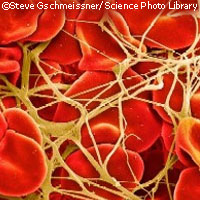FP6 project finds new platelet receptors
A project funded under the Sixth Framework Programme (FP6) has discovered previously unknown platelet receptors. There are many different types of receptors on platelets. Some bind small molecules, which help activate the platelet. Other receptors on the surface of platelets help the platelet adhere to sites of vascular injury. The Bloodomics team, whose main objective is to find genetic markers for the prediction of thrombus formation in coronary artery disease, believe that the newly discovered receptors play a role in platelet activation. 'The Bloodomics discovery is very important, as it helps us understand links between platelets and clot formation,' explains Willem Ouwehand, Bloodomics coordinator and Director of Research and Planning at the European Cardiovascular Genetics Foundation (ECGF). 'Now we are trying to understand the impact this and other novel receptors have on the development of heart disease, with the ultimate aim to better prevent heart disease in the future.' The Bloodomics scientists are focusing primarily on the genetics and cell biology of platelets, hypothesising that the response of platelets to plaque rupture is critical in determining whether or not thrombus formation will lead to the obstruction of the arterial blood vessel.



